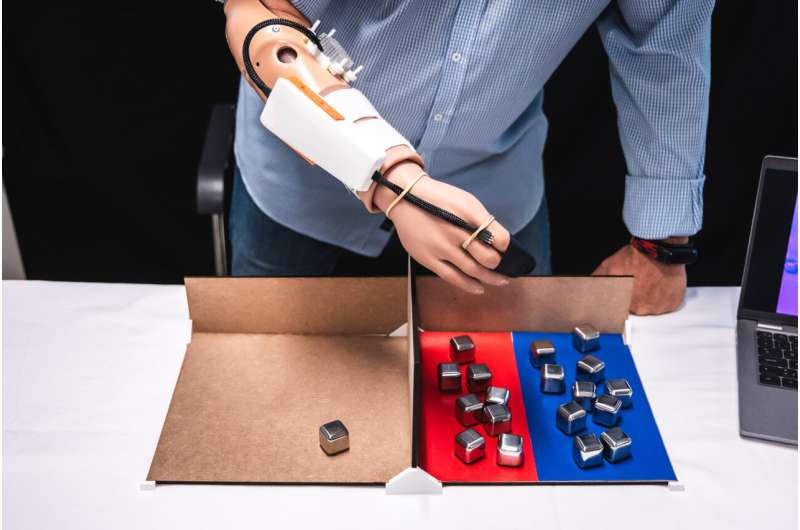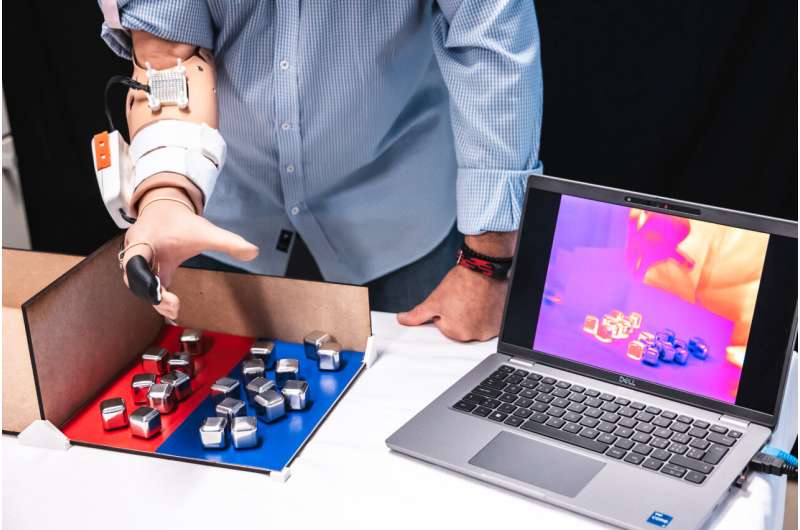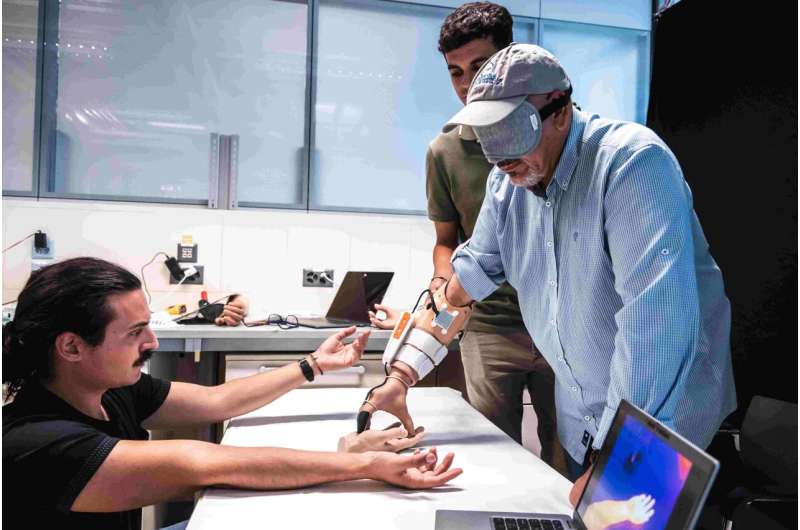This article has been reviewed according to Science X's editorial process and policies. Editors have highlighted the following attributes while ensuring the content's credibility:
fact-checked
peer-reviewed publication
trusted source
proofread
Temperature-sensitive prosthetic limb improves amputee dexterity and feelings of human connection

Sensory feedback is important for amputees to be able to explore and interact with their environment. Now, researchers have developed a device that allows amputees to sense and respond to temperature by delivering thermal information from the prosthesis' fingertip to the amputee's residual limb.
The "MiniTouch" device, presented in the journal Med, uses off-the-shelf electronics, can be integrated into commercially available prosthetic limbs, and does not require surgery. Using the thermally sensitive prosthetic hand, a 57-year-old transradial amputee was able to discriminate between and manually sort objects of different temperatures and sense bodily contact with other humans.
"This is a very simple idea that can be easily integrated into commercial prostheses," says senior author Silvestro Micera of École Polytechnique Fédérale de Lausanne and Scuola Superiore Sant'Anna. "Temperature is one of the last frontiers to restoring sensation to robotic hands. For the first time, we're really close to restoring the full palette of sensations to amputees."
The team previously showed that their thermosensitive technology could restore passive thermosensation in 17/27 amputees. In the new study, they show that the MiniTouch can be easily integrated into commercial prosthetic limbs and that it enables active thermosensation during tasks that require feedback between sensory and motor neurons.
Beyond the functional importance of being able to sense hot and cold, thermal information could also improve amputees' sense of embodiment and their ability to experience affective touch.
"Adding temperature information makes the touch more human-like," says senior author Solaiman Shokur of École Polytechnique Fédérale de Lausanne. "We think having the ability to sense temperature will improve amputees' embodiment—the feeling that 'this hand is mine.'"
To do this, they integrated the MiniTouch into the personal prosthesis of a 57-year-old male who had undergone a transradial amputation 37 years earlier by linking the device to a point on the participant's residual limb that elicited thermal sensations in his phantom index finger. Then, they tested his ability to distinguish between objects of different temperatures and objects made of different materials.

Using the MiniTouch, the participant was able to discriminate between three visually indistinguishable bottles containing either cold (12°C), cool (24°C), or hot (40°C) water with 100% accuracy, whereas without the device, his accuracy was only 33%. The MiniTouch device also improved his ability to quickly and accurately sort metal cubes of different temperatures.
"When you reach a certain level of dexterity with robotic hands, you really need to have sensory feedback to be able to use the robotic hand to its full potential," says Shokur.
Finally, the MiniTouch device improved the participant's ability to differentiate between human and prosthetic arms while blindfolded—from 60% accuracy without the device to 80% with the device. However, his ability to sense human touch via his prosthesis was still limited compared to his uninjured arm, and the researchers speculate that this was due to limitations in other non-thermal sensory inputs such as skin softness and texture. Other technologies are available to enable these other sensory inputs, and the next step is to begin integrating those technologies into a single prosthetic limb.

"Our goal now is to develop a multimodal system that integrates touch, proprioception, and temperature sensations," says Shokur. "With that type of system, people will be able to tell you 'this is soft and hot," or 'this is hard and cold.'"
The researchers say that their technology is ready for use from a technical point of view, but more safety tests are needed before it reaches the clinic, and they have plans to further improve the device so that it can be more easily fitted.
Future models could also build upon the Minitouch to integrate thermal information from multiple points on an amputee's phantom limb—for example, allowing people to differentiate thermal and tactile sensations on their finger and thumb might help them grasp a hot beverage, while enabling sensation in the back of the hand might improve the feeling of human connection by allowing amputees to sense when another person touches their hand.
More information: A sensory-motor hand prosthesis with integrated thermal feedback, Med (2024). DOI: 10.1016/j.medj.2023.12.006. www.cell.com/med/fulltext/S2666-6340(23)00404-X


















